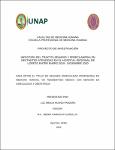Infección del tracto urinario y preeclampsia en gestantes atendidas en el Hospital Regional de Loreto entre enero 2019 - diciembre 2020
Abstract
INTRODUCTION. (UTI) Urinary tract infection; is the existence of germs capable of producing functional and morphological alterations in the bladder, collecting systems or kidneys. Most cases with UTI depend on the many maternal and epidemiological factors that will be evaluated, as well as associated with Preeclampsia Disease (PD). It has been defined as the presence of proteinuria> 300 mg, plus arterial hypertension ? 140/90 after the 20th week of gestation as minimum criteria. Its causes are various maternal alterations, to this are added the absence of prenatal controls, for the main reason that brought the COVID 19 pandemic and the increase in the health crisis in addition to the limited access to health services. Some world reports evidenced 19 cases of UTI during pregnancy with a high risk factor for the development of PD. Therefore, this study aims to strengthen the knowledge of the direct and indirect impact of UTI in patients with Preeclampsia, in order to reduce maternal-fetal complications and risks.
OBJECTIVE. To determine the association between urinary tract infection and preeclampsia in pregnant women treated in the obstetrics and gynecological service of the Hospital Regional De Loreto "Felipe Santiago Arriola Iglesias" in the period January 2019 to December 2020. METHODOLOGY. Retrospective, cross-sectional, descriptive and quantitative study; The sample consisted of 85 pregnant women treated at the “Felipe Santiago Arriola Iglesias” Regional Hospital of Loreto, treated with the inclusion criteria. Only those with incomplete medical records were excluded. The type of sampling was non-probabilistic and the census technique because the entire population was considered. RESULTS: Once the approval of the investigation project has been obtained, the evaluation and permission will be requested from the research committee and
committee of the Regional Hospital of Loreto. For data collection, the medical records were analyzed using the data collection form with the SPSS 25 software, where descriptive statistics will be applied, presenting the results in absolute and relative frequency tables with graphs in Excel 2013. CONCLUSION: They will be obtained according to the results. INTRODUCCION. La infección de vías urinarias (ITU) se define como la existencia de microorganismos capaces de producir cambios funcionales y morfológicas en la vejiga, sistemas receptores de pasaje o riñones. La mayoría de casos con ITU dependen de los muchos factores, maternos y epidemiológicos que se evaluaran, asi mismo asociado con Enfermedad Preeclamsia (EP). Que se ha definido como la presencia de proteinuria > 300 mg, más hipertensión arterial ? 140/90 después de la semana 20 de gestación como criterios mínimos. Sus causas son diversas alteraciones de la maternas, a esto se suman las inasistencias de controles prenatales, por motivo principal que trajo la pandemia del COVID 19 y el incremento de la crisis sanitaria además el limitado acceso a los servicios de salud. Algunos reportes mundiales evidenciaron 19 casos de ITU durante el embarazo con un factor de riesgo para el desarrollo de EP. Por lo que este estudio pretende incrementar los conocimientos de la incidencia directa e indirecta de la ITU en pacientes con Preeclamsia, para asi disminuir las complicaciones y riesgos maternos fetales. OBJETIVO. Establecer la vinculación entre infección del sistema urinario y
preeclampsia en gestantes atendidas en el servicio de ginecobstetricia del Hospital Regional De Loreto “Felipe Santiago Arriola iglesias” en el periodo enero del 2019 a
diciembre del 2020. METODOLOGIA. Estudio tipo retrospectivo, transversal, descriptivo y cuantitativo; La muestra fueron 85 gestantes atendidas en el Hospital Regional De Loreto “Felipe Santiago Arriola Iglesias”, atendidas con los criterios de inclusión. Fueron excluidas solo las que se constataba de historias clínicas incompletas. La clase de muestreo fue no probabilístico y la forma censal porque se consideró a toda la población. RESUTADOS: Se obtuvo la conformidad del proyecto de investigación, por el cual se solicitará la evaluación y permiso al comité de investigación y comité del Hospital de la región. Para la acumulación de datos, se evaluó las historias clínicas mediante el instrumento de recolección de datos con el software SPSS 25, donde se empleará estadística descriptiva, mostrando los resultados en tablas y cuadros de frecuencia absoluta y relativas con graficas en Excel 2013. CONCLUSION: Se obtendrán de acuerdo a los resultados.


